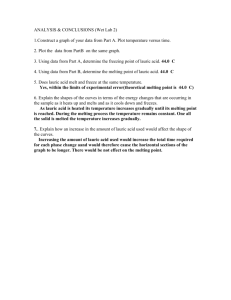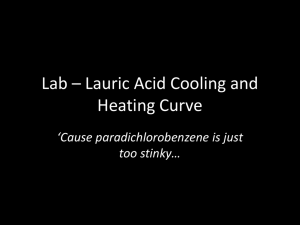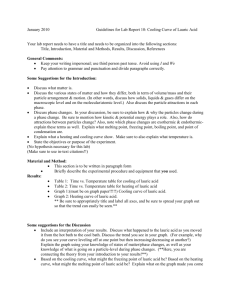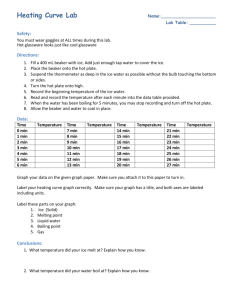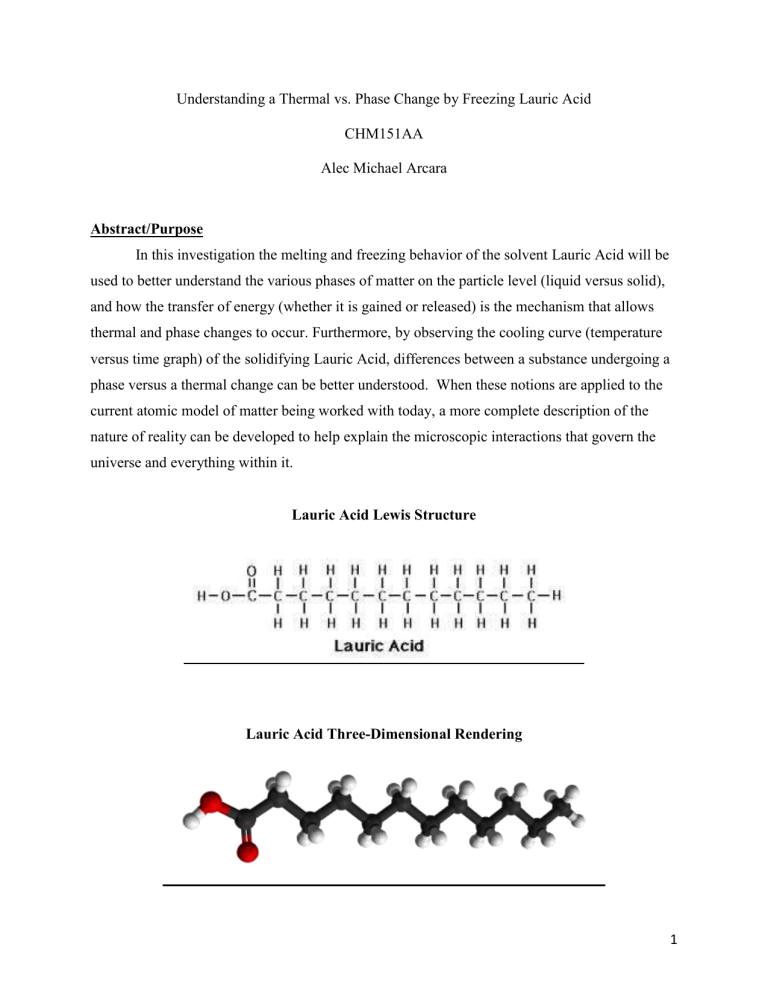
Understanding a Thermal vs. Phase Change by Freezing Lauric Acid CHM151AA Alec Michael Arcara Abstract/Purpose In this investigation the melting and freezing behavior of the solvent Lauric Acid will be used to better understand the various phases of matter on the particle level (liquid versus solid), and how the transfer of energy (whether it is gained or released) is the mechanism that allows thermal and phase changes to occur. Furthermore, by observing the cooling curve (temperature versus time graph) of the solidifying Lauric Acid, differences between a substance undergoing a phase versus a thermal change can be better understood. When these notions are applied to the current atomic model of matter being worked with today, a more complete description of the nature of reality can be developed to help explain the microscopic interactions that govern the universe and everything within it. Lauric Acid Lewis Structure Lauric Acid Three-Dimensional Rendering 1 Background The substance being observed, documented, and analyzed in this lab is Lauric Acid, also known as Dodecanoic Acid. Lauric Acid, with a chemical formula of C12H24O2, is saturated fatty acid that occurs naturally in many plant and animal fats/oils and is typically known to have close resemblance to coconut oil. In terms of their chemical properties, both Lauric Acid and coconut oil share high boiling and high freezing points as well as the same white-translucent crystalline appearance. The Lauric Acid’s high temperature freezing point will be useful in observing the substance undergoing a phase change from a liquid to a solid in a relatively short amount of time, completing this transformation in just under 20 minutes. In order to better understand the behavior of matter when it is heated or cooled, the notions of energy storage accounts and Kinetic Molecular Theory needs to be discussed. Kinetic Molecular Theory (KMT) is a simple microscopic model that effectively describes the behavior of matter in terms of moving particles. Simply put, KMT postulates that all matter is composed of tiny particles (atoms) that are in constant random motion. The more energy that exists in a system, the faster and more randomized the motion of the particles contained within it. If a system is heated up, its particles gain kinetic energy consequently accelerating them and increasing their average speed. If a system is cooled down, its particles lose kinetic energy decelerating them and decreasing their average speed. This is important when it comes to understanding why thermal and phase changes occur when a substance is heated or cooled. When energy is transferred into or out of a system it is important to keep track of where this energy is being stored and how it is affecting the particles (atoms) contained within it. For this experiment, the Lauric Acid’s thermal energy and phase energy will be what’s examined and accounted for. Thermal energy represents the temperature of a system and is the energy stored by the motion of a large collection of the Lauric Acid’s particles. Its quantity is directly proportional to both their mass and velocity via Kinetic Molecular Theory. Phase Energy is the energy stored in a system strictly due to the arrangement of its particles and the adhesive intermolecular forces that bond those particles together. 2 Materials Lab-approved protective safety goggles Vernier LabQuest Mini sensor interface Vernier stainless steel temperature probe Laptop with Logger Pro software installed Hot plate Test tube half filled with Lauric Acid (C12H24O2) 600ml Beaker 250ml Beaker Ice and Water Procedure 1. Put on protective goggles. 2. Insert temperature probe into CH1 of the LabQuest interface, connect the interface via USB to the laptop. 3. Start LoggerPro and configure the software to collect the temperature data in time-based intervals of one sample per second for 20 minutes. 4. The instructor will have already setup the initial conditions to begin the lab. This includes placing the 600ml beaker filled with water and multiple test tubes of Lauric Acid onto the hot plate and allowing them to heat up enough to allow the Lauric Acid to exist in its liquid state. 5. Fill the 250ml beaker about a quarter full of ice, then add water from the sink to where the ice-water bath reaches the 200ml line marked on the beaker. 6. Insert the temperature probe into one of the vials of Lauric Acid contained in the hot water bath of the 600ml beaker. 3 7. Remove the vial of Lauric Acid with the inserted temperature probe from the 600ml beaker and wait for the temperature to stabilize. 8. Once the temperature of the Lauric Acid is stabilized, insert the vial into the 250ml beaker filled with the ice-water and start collecting data. 9. While collecting the data be sure to continuously stir the Lauric Acid solution as it cools with the temperature probe. Once the solution begins to solidify there is no further need to stir the solution. Be sure to observe the change in appearance and texture of the Lauric Acid as the experiment continues. Finish collecting the data once the temperature of the Lauric Acid stops decreasing and save the graph created by LoggerPro Graph A B C 4 Observations and Discussion Section A: At the macroscopic level, the translucent oil began to have an uneven distribution of cloudy-white patches. As the temperature further decreased, the cloudy-white patches became more evenly distributed; simultaneously, the oil itself was becoming thicker, less viscous and losing its fluid-like properties. At the microscopic level, the decrease in temperature confirms that thermal energy is being expended out of the system. Kinetic Molecular Theory states that the Lauric Acid’s molecules are losing kinetic energy, indicating that its particles are slowing down and becoming more condensed as their motion becomes less randomized. This is represented by the velocity vectors of the particles in the diagram below. Hot Liquid Section B: At the 60 second mark, the temperature of the Lauric Acid plateaus at 43.6 degrees Celsius. On the macroscopic level, the once translucent solution became almost completely white in its appearance. The once viscous and free-flowing oil has evolved into a thick liquid that was beginning to crystalize into solidified condensates. The temperature probe could no longer move freely and became fixed in place. Though the temperature remained at a constant 43.6 degrees Celsius, clearly a change was still taking place within the Lauric Acid solution. 5 At the microscopic level, the system has expelled enough thermal energy where the acid’s molecules have had their motion restricted and condensed into tightly packed configuration. This uniform molecular distribution adequately allows the acid’s molecules to experience strong enough intermolecular forces between them that consequently rearranges the particles into a compressed lattice-like structure. This indicates that instead of the energy loss translating to a decrease in temperature, it is translated into allowing the liquid solution to undergo a phase change into a solid solution. After about a minute into Section B, the phase change is completed. The Lauric Acid’s molecules are fixed in place and can no longer move freely throughout the substance. The only movement taking place are the microscopic low energy vibrations of the molecules themselves, indicating that the Lauric Acid is effectively frozen. This phase change of the freely moving particles in a liquid to the fixed particles of a solid is represented by the particle diagram below. Section C: After the phase change is completed, the frozen Lauric Acid again begins to experience another temperature drop. At the macroscopic level the substance’s appearance is identical to that of solidified coconut oil or vegetable shortening. It had a bright white hue that was thick and uniformly distributed. However, it also appeared to contain individual crystalline and powderedlike solids within its structure. Its appearance and physical properties showed no signs of variation as the solidified Lauric Acid experienced its decline in temperature. 6 At the microscopic level the C12H24O2 molecules are still fixed in place and experienced low energy vibrations. However as the temperature further decreased, the kinetic energy of these vibrations decreased as well. This allowed the molecules to become even more compressed and tightly packed together. This is because Kinetic Molecular Theory’s postulates still hold true under these circumstances, making it an effective model to describe particle behavior in all three energy phases of matter. Conclusion Kinetic Molecular Theory (KMT) is an extremely useful model when it comes to describing the behavior of matter in terms of moving particles. The various kinetic energies involved in the three phases of matter effectively explain why a substance that is hot or cold behaves the way it does and how it interacts with other substances. However, KMT’s usefulness expires when it comes to describing the specific interactions between particles as a substance undergoes a phase change from a solid, liquid, or gaseous state. Throughout the entirety of the experiment energy was being removed from the Lauric Acid solution. KMT could only explain what was occurring on the particle level during a thermal change (a change in temperature) yet was ineffective when it came to describing why the graph plateaued the way it did. The existence of increasingly adhesive intermolecular forces when a substance loses enough energy, combined with KMT’s principles, effectively describes the behavior of the Lauric Acid’s molecules throughout the entirety of the experiment and gives a deeper insight into the microscopic cosmos that compose all of existence. This experiment, and a plethora of many others, demonstrate why it is useful to utilize a multitude of models when employing the scientific process to better understand the nature of reality. 7
